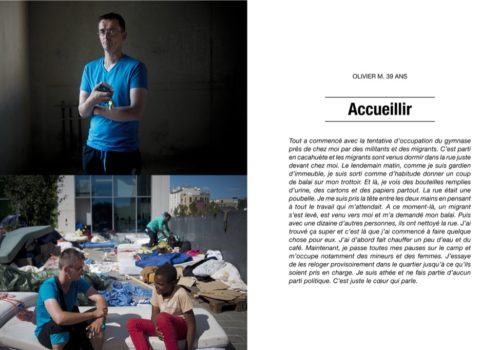From January 12 to March 11, Bertrand Gaudillère and Catherine Monnet’s project was exhibited at the public library in the First Arrondissement in Lyon.
In May 2015, a large number of people fleeing war zones found refuge in France, in Paris, underneath the elevated metro (Porte de la Chapelle). These people, referred to as “migrants,” are waiting to be granted refugee status by the French state. They are Eritreans, Sudanese, and Ethiopian, but above all, they are 350 human beings, among whom 150 are applying for asylum, while 200 are in transit to other destinations, such as the UK or Northern European countries.
For reasons of hygiene, the makeshift camp was evacuated in June by the police. The refugees scattered across the city, soon pitching new camps. The police then received the order to dismantle those new camps, often quite callously. Local residents, citizens, were deeply offended by the police brutality against the refugees. They united in a new form of solidarity. It was at that moment that Bertrand Gaudillère, a photojournalist and member of the collective Item in Lyon, and Catherine Monnet, a journalist and former senior reporter at Radio France Internationale, came up with the idea of the project Justes solidaires.
Could you tell us what your project is about?
Betrand Gaudillère: Our project is neither a photographic subject nor a written subject. It’s an ongoing dialog between image and text. I have no personal claim on this project without Catherine’s collaboration. The work involves not just photography, but also photojournalism. No element of the project can stand alone!
Catherine Monnet: It may seem obvious, but we put hours of thought into it! Our project has four components: two photos, an action verb, and a text which is a transcription of each of the volunteers’ interviews.
What did you want to convey with this series of fifteen portraits?
C.M.: We wanted to show several things. To start with, who is helping? We often imagine that volunteers are all either retirees who have nothing better to do, or leftists who can afford to volunteer! I’m of course intentionally exaggerating here. The reality is, as we realized, that an astonishingly diverse crowd came out to help. Everyone had a different socioeconomic background. This is what we wanted to highlight. So we came up with the idea of a pair of photos. First, there is an intimate portrait of the person in their home. This shows that all volunteers belong to very different worlds, and there is no typical profile that would predispose a person to volunteer.
Next, we wanted to illustrate the idea that there are as many ways of helping as there are people! This is the meaning behind the action verb, which is also our entry into the subject. We explain that there isn’t just a single way of helping (whether by entertaining, sheltering, or caring…), but above all, that there is no such thing as a small action. Everyone may help according to their abilities and within their means. One doesn’t need to be a lawyer or a nurse… The photograph “in action” presents the volunteers in the field. It follows up on the verb, and concretely shows how one can help the migrants.
How would you describe your approach: is it political or simply humanist?
B.G.: Clearly, there is a political aspect, in the sense that “this [i.e. police violence] is unacceptable.” But the discourse is more focused on people: we are talking about the moment when we wake up from our indifference. The way these people [the volunteers] spoke about immigration was very different: they didn’t see it as a social, political, or economic problem, but as a human issue.
For the past ten years, my work has revolved around the idea of putting a human face to the numbers. We often talk about immigration in terms of ratios, statistics: “how many Sudanese, how many Eritreans… .” What I am going to say is painfully banal, but in this project our concern is being human toward human beings. There are no good or bad refugees, simply people who are in need. By looking at things this way, it is possible to engage in dialog, to extend a helping hand, to build bridges.
C.M.: We adopt a documentary approach more than anything else. That is to say, we wanted to voice an opinion, to shed light on a situation that we encountered in the field. In order to do that, we devised a method capable of portraying the state of things.
Interview by Marion Moret
Marion Moret is a journalist based in Marseille, France.
The exhibition is part of the project “La France vue d’ici” supported by the photo festival Images Singulières and the online journal Mediapart.
https://www.bm-lyon.fr/nos-blogs/democratie/?lang=fr
https://blogs.mediapart.fr/616712/blog/311216/justes-solidaires
















